RAKE ANGLE - The grind angle of a gravers face as measured in
degrees from a perpendicular. Most gravers use a face of from 45 to 65
degrees however they may be sharpened as steep as 90 degrees. Also
known as the face angle.
|
RECEIVER – The part of a gun that takes the charge from the
magazine and holds it until it is seated in the breech. Specifically
the metal part of a gun that houses the breech action and firing
mechanism: In revolvers and hinge frame or basculating shotguns and
rifles, called the “frame”; in some types of autoloading pistols the
terms “frame” and “receiver” are used synonymously. In engraved guns
the receiver is the most significant portion to be engraved due to its
greater mass as compared with the small parts or furniture.

Pictured is the engraved and inlayed receiver of a Winchester model 12
slide action shotgun.
|
RECOIL SHIELD – In a revolver it is the flange or hemispherical
boss on the standing breech to prevent cartridges in the chambers or
percussion caps from moving backward far enough to interfere with the
rotation of the cylinder. A frequently engraved portion of a revolver’s
frame.
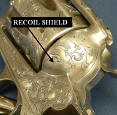
|
RELEVOUR – A word Belgian engravers use to describe a type of
chisel used for preparing a metal surface for inlay or overlay of
precious metal.
http://www.handengravingforum.com/showthread.php?t=2312
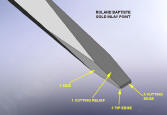
Pictured is a diagram of a Roland Baptiste inlay tool which is a type
of relevour.
|
RELIEF ENGRAVING – Cutting away of the background metal so that
the designs or figures appear to project above the surface of the
surrounding metal. High relief engraving has the background cut away
deeper than medium relief and the foreground is usually sculpted.
Bas-relief, also known as “low relief,” does not have the background
cut away; the background is stippled or matted to give the illusion of
relief. In art high relief is also known as alto relievo.
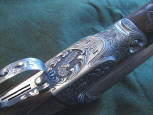

Shown here are pictures of a Parker shotgun engraved in high relief by
Carl B. Bleile of Cincinnati.
|
RELIEVING FACETS – In the process of sharpening a square graver,
relieving facets are ground on the underside to set the angle of the
belly (or width of the graver such as 90, 116, or 123 degree) and
provide clearance with the metal being engraved. All hand engravers do
not grind in relieving facets on square gravers, as there are numerous
approaches to sharpening gravers. Relieving facets are a feature of the
Lindsay Uniform Parallel Point™ method of sharpening.
http://www.engravingschool.com/priva...oint-Intro.htm

Pictured is a diagram of a graver sharpened with the Lindsay Patented
Parallel Point with the relieving facets and heel indicated by arrows.
|
RENAISSANCE ORNAMENT – Of or being the style of architecture and
decoration, based on classical models, that originated in Italy in the
15th century and continued throughout Europe up to the end of the 16th
century. In gun engraving “Renaissance” is used to denote a florid
style of scrollwork found in Roman architecture and is most commonly
found on high-grade Belgian and Italian guns.
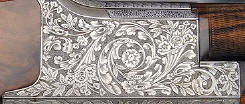
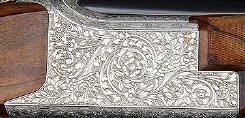
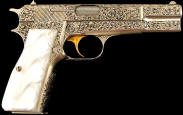
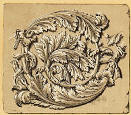
Pictured are two Belgian Browning shotguns engraved in "renaissance"
scroll, a Browning High Power pistol engraved in Browning's
"renaissance" pattern and an illustration of renaissance ornament.
|
REPOUSSÉ - Shaped or
decorated with patterns in relief formed by hammering and pressing on
the reverse side. Used especially in metal, repoussé is also used to
mean the technique of hammering and pressing designs in relief.
|
RICCIOLO or RICCIOLI – Italian: Literally curl or curls.
Used by Italian speaking engravers to mean scroll or scrolls as used by
English speaking engravers.
|
RIFFLER – A small, fine file, made in various shapes, used to
sculpt or model relief engravings or inlays.

|
RIMESSO IN ORO – Italian: Gold inlay.
|
ROCOCO – A style of art, especially architecture and decorative
art, that originated in France in the early 18th century and is marked
by elaborate ornamentation, as with a profusion of scrolls, foliage,
and animal forms. Rococo ornamentation, particularly scrollwork, is
used by hand engravers today primarily on 18th century style firearms
and accouterments.
|
ROLAND BAPTISTE SHARPENING TEMPLATE – A sharpening template
manufactured and distributed by Steve Lindsay Engraving & Tools of
Kearney, Nebraska and designed by noted Belgian gun engraver Roland
Baptiste. The Baptiste template provides consistent shaping and
sharpening of a relevoir, which is a type of chisel used in the
preparation of a metal surface for the inlay or overlay of precious
metal.
http://www.handgravers.com/sharpening.htm#Uniform-Parallel Point
http://www.handengravingforum.com/showthread.php?t=2312
http://www.engravingforum.com/showthread.php?t=2400
http://www.engravingforum.com/showthread.php?t=3134


Pictured are the Roland Baptiste templates and an illustration of the
finished tool.
|
ROLLING MILL – A rolling mill is a machine for shaping metal by
passing it between a pair of work rolls. For engravers, goldsmiths, and
silversmiths mainly two types are used, a flat one (with two
cylindrical rolls) for rolling sheet and one with grooved rolls for
rolling octagonal wire. The rolls are made of hardened steel.
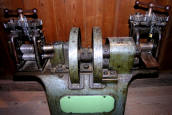
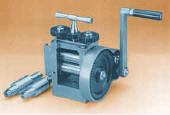
Pictured are two examples of manually operated rolling mills.
|
ROMAN LETTERING - Roman letters are composed of thick and thin
lines terminated with small crosstrokes called serifs. The serifs lend
unity to letters and blend the letters into easily read words. Roman
typefaces are divided into two styles: old style and modern. The chief
difference between old style and modern roman letters is the serifs.
Old style roman letters have soft-rounded serifs, while the serifs on
modern roman letters are heavier with clean-cut hairlines.
Roman lettering is one of the most common types of lettering executed
by hand engravers, the others being Blackletter, Gothic, Old English,
and script. Roman letters are characterized by thick uprights and the
addition of serifs.
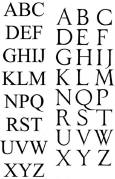
|
ROSE and SCROLL - This style of arms decoration consists of a
combination of small English scroll and clusters of flowers (usually
roses). The most common style of engraved decoration on British
sporting guns, especially in the 19th and early 20th centuries. French:
Anglaise a bouquet, German: Rosenbukett mit altenglischen Arabesken,
Italian: Inglesina e bouquet di fiori.
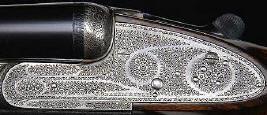
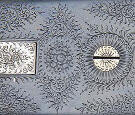
Pictured are two typical examples of rose and scroll engraving on
British made shotguns, a Graham and a Purdey.
|
ROSE ENGINE ORNAMENTAL ENGRAVING MACHINE – A type of geometric
lathe used for engraving intricate patterns into metal. The Rose engine
is especially used to create guilloche patterns as often found on
antique watchcases. Read more about Rose engines and geometric lathes
at this thread:
http://www.handengravingforum.com/showthread.php?t=2862

|
ROSENBOUKET – German: Rose and bouquet. German speaking
engravers use Rosenbouket or Rosenbouket mit altenglischen Arabesken to
describe what English speaking engravers call “rose & scroll.” In
French it is known as Anglaise a bouquet and in Italian: Inglesina e
bouquet di fiori.
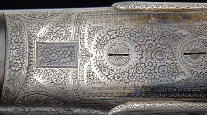
Pictured is the floor plate of a shotgun by Johahn Springer of Vienna,
Austria engraved in the style of Rosenbouket mit altenglischen
Arabesken.
|
ROSETTE – A circular and symmetrical design used by engravers to
decorate circular projections such as hinge pins, rivets, and screw
heads.
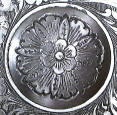
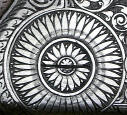

|
ROTARY GRINDER – A power driven tool that uses a high speed
rotating cutter or burr to grind away a solid object such as metal,
wood, or glass.
Also known as a rotary tool, there are basically three types of rotary
grinder. The most commonly known is the Dremel as manufactured by the
Robert Bosch Tool corp. With the Dremel type rotary tool the cutter or
burr is driven directly from the center shaft of an electric motor.
This type operates at speeds up to 35,000 rpm. The Dremel style rotary
grinder is rarely, if ever used by hand engravers.
The second type operates in conjunction with a flex shaft attached to
an electric motor and is commonly known as a Fordom tool as made by
Blackstone Industries, Inc. Jewelers for shaping, grinding and
polishing commonly use this type. The flex shaft makes it possible to
have a more powerful motor and a smaller hand piece than the Dremel.
The Fordom tool has a maximum rpm of 16,000 and is rarely used in the
hand engraving process.
The third type of rotary grinder is operated by air pressure and is
very similar to the tool used by dentists to drill teeth. Pneumatic
rotary grinders are powered by air pressure operating a turbine and can
run at speeds as high as 400,000 rpm and as a result are capable of
more precise work because they are more controllable and do not impart
the torque of a motor. Some hand engravers use this type of rotary tool
for background removal instead of the more traditional method of
background removal with a graver.
http://airgraver.com/NSK_rotary.htm

|
ROUND GRAVER – A traditional style graver which when viewed from
the face has a rounded tip. Round graver blanks are found in sizes
numbered from #50 to #63.


Pictured is a traditional graver blank and the face profile of a round
graver.
|
RUNNING INITIALS – Used to denote three interwoven letters
located on a horizontal plane.
|
RUNNING WHEAT - A design used for borders, it resembles wheat
chaff laid end-to-end. Also known as "wheat chaff."
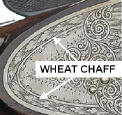
|